 |
|

|
 |
TABLE of CONTENTS
 |
RTMC team gives motorists another source of travel information with 511 mobile app |
By Chris Krueger, Metro District Public Affairs
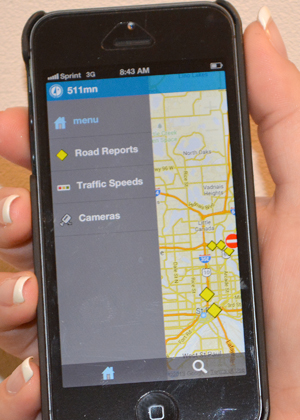
New 511 app can be downloaded on iPhone and Android smartphones. Photo by Rich Kemp |
MnDOT launched a free mobile 511 app on Friday, July 12, and within 48 hours more than 6,000 people had downloaded the source of travel information to their iPhone and Android smartphones.
“A mobile 511 app is an important tool that the growing number of people who use smartphones can use to determine the best route to arrive at their destination on time,” said Brian Kary, freeway operations engineer. “The 511 mobile app is intended to be used before motorists hit the road and should never be used while driving.”
Reviews on the Apple website were positive: “The app is much more straightforward than the browser attempts I’ve seen, and it has a quick way to both the map and the cams. Nice job. Don’t use while driving!” reads one review. “Good app. Good info,” reads another.
The mobile app features all the construction, maintenance, crashes and road incidents currently available on MnDOT’s www.511mn.org website.
To develop this smartphone app, Kary and Kelly Braunig, MnDOT’s 511 coordinator, worked with Castle Rock, the software network management company that also supports Minnesota’s 511 websites and telephone for MnDOT. A handful of other states also offer these services and similar smartphone apps free for mobile phones.
Before downloading the app, the user sees this message: Be safe. Do you agree not to use this application while driving?
The app features a zoomable map with clickable icons for information on traffic incidents, winter road conditions and images from MnDOT’s freeway cameras. Users also can access Google’s traffic data that helps drivers determine how much time a trip will take, based on current traffic conditions.
Users can find the app online at the Apple store and at Google Play store. |
 |
|

|
|

|
 |
TABLE of CONTENTS
 |
Project update: I-35E improvement project |
By Kirsten Klein, Metro District Public Affairs
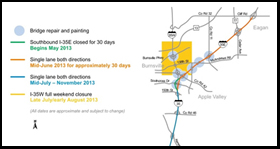
Concrete repair work and bridge repairs are part of the Interstate 35E project in Eagan. |
The Interstate 35E portion of the south metro resurfacing project is nearly complete. This project is one of several occurring during the summer on interstate between Elko/New Market and Eagan.
The kickoff for the I-35E Project started with a series of closures the weekend of May 3. The first closure was of both northbound I-35W and southbound I-35E on Friday night. On Saturday evening, southbound 35W was also closed for one night as crews removed the deck of the southbound I-35E bridge that spanned I-35W. By Monday morning all the lanes of I-35W were open and the 30-day closure of southbound I-35E was underway.
Once the re-deck of the I-35E Bridge was complete and the road re-opened to traffic, crews built the crossovers for the next phase of the concrete repair work. In that stage motorists were moved to one side of the road in a head-to-head formation and have remained ever since.
The month-long closure of the bridge wasn’t the only closure the motorists have faced with this project. Since then the ramps at County Road 11 and the southbound I-35E/Cedar Avenue have closed, along with the McAndrews Road Bridge.
Before the project ends, the ramps to and from northbound I-35E and Cedar Avenue will close as crews finish concrete repairs along the collector distributer lanes. There also will be two more weekend closures of I-35W, as crews paint the bridges at County Road 42, County Road 38 and the I-35E Bridge that spans I-35W.
The project is scheduled to be complete by the end of July with the exception of the weekend closures in August, when the bridges are painted. Track the I-35E improvement project at: www.dot.state.mn.us/metro/projects/i35eelkotoeagan/. |
 |
|

|
|

|
 |
TABLE of CONTENTS
 |
New collaboration tool for projects, teams to be available in August |
|
By Rich Kemp
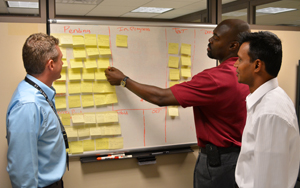
From left; Paul Weinberger, systems supervisor; Garland Jackson, systems analysis unit supervisor; and Sayeed Rahman, business solutions manager; discuss the remaining tasks for the SharePoint program. Photo by Rich Kemp
|
SharePoint, a collaboration and document management tool for projects and teams, will be available for request Aug. 22.
“We anticipate a heavy load at the beginning,” said Paul Weinberger, systems supervisor. “We have to make sure that the criteria set by MnDOT are taken into account when determining which ones are first to be delivered, based on meeting the greatest business value for the organization.”
SharePoint features include:
- Sites for teams and projects to manage activities with others and publish information from a single location
- Ability to coordinate and share knowledge with colleagues to work together on documents, tasks, issues, etc.
- Ability to post announcements, related links to commonly accessed websites, decisions and group calendars
- Storage and organization of a variety of file types, including documents, emails, pictures
- Metadata (data about the data) that helps categorize the information and allows for easier search and filtering to quickly locate what you need
- Places to post questions, opinions, ideas to share information and expertise
- Electronic routing of documents for approval or to collect feedback in sequential or parallel order
“The SharePoint project was born within the Tech Connections Flagship Initiative, which seeks to use technology to promote a culture of innovation, and foster collaboration within the agency,” said Jean Wallace, Policy Analysis, Research and Innovation director. “SharePoint is a solution to a problem that was identified by employees who wanted to have a way to reduce emails, email attachments, and find a better way to collaborate through technology.”
“It has been a long time coming,” added Garland Jackson, systems analysis unit supervisor. “I am excited to be able to offer this service and provide some return on investment and business value.”
To request a SharePoint site, the user will fill out an online form. The office director or district engineer will receive notice of the request and will have to approve the site.
Site requests will be selected based on:
- IT prioritization criteria (established by Division Directors)
- Mandatory
- Department strategic
- Major departmental benefits
- Beneficial
- Nice to have
- Avoid
2. Benefit
- Number of users
- Frequency of site usage
- Cost/time savings and/or efficiency gains
3. Complexity
How can you learn more?
- Computer-based training is available in the MnDOT Learning Center (Pathlore). It is divided by modules based on role and/or topic area. Each course averages 10-12 minutes and can be taken from your computer at your convenience .
- Hands-on training will be scheduled for people associated with a site as it is made available.
|
 |
|

|
 |
TABLE of CONTENTS
 |
Employee safety continues to be at top of governorís programs |
By Rich Kemp
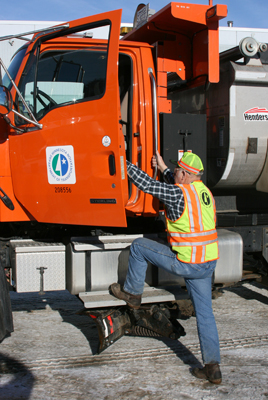
The 3-point contact rule is important when climbing in and out of vehicles. Photo by Rod Starky, District 2. |
Gov. Mark Dayton’s commitment to decrease workplace injuries on the state workforce is starting to pay off through the efforts of MnSAFE, according to Todd Haglin, MnDOT safety director. MnDOT has seen a reduction in work comp claims and is on track to meet the goal of a 10 percent reduction in the work comp incident rate for FY 2013.
“We had a good year,” Haglin said. “We were able to achieve most of the FY13 MnSAFE goals and objectives.”
The governor’s mission is to achieve a 25 percent reduction in the rate of workplace injuries for all state agencies by the end of FY 2014.
“The number of worker comp claims is trending downward, which is putting us in a good position to achieve the 25 percent reduction by the end of FY 2014,” said Haglin.
MnDOT has submitted MnSAFE workplace safety goals for FY 2014. Most of these goals will focus on implementing action items based on the results of the brainstorming event held last October.
“We appreciate all of the effort from the employees at MnDOT and encourage everyone to continue safe practices as we decrease our workplace injuries,” said Susan Mulvihill, deputy commissioner and chief engineer.
Put your creativity into promoting safety: enter poster contest
In addition to the efforts being made by the individual state agencies, the Department of Administration is sponsoring a poster contest to boost awareness of workplace safety. The posters should relate to identified themes and promote safe behaviors. The poster template is available online at www.mn.gov/mnsafe/documents/mnsafe_poster_template_P.doc.
Candidate posters must be submitted to Admin Risk Management by Sept. 20 to be included in the contest. Submit posters to todd.christenson@state.mn.us. The winners will be recognized at Admin's Safety & Loss Control Conference in October. For complete details on the poster themes and contest rules go to: www.admin.state.mn.us/mnsafe/documents/mnsafe_poster_contest.pdf. |
|
 |
|

|
 |
TABLE of CONTENTS
 |
State fair exhibit to focus on transportation funding |
By Lisa Yang

At right, Lynn Page, District 2 transportation specialist, talks to fairgoers at the MnDOT booth at the 2012 Minnesota State Fair. Photo by David Gonzalez |
MnDOT continues its presence this year at the Minnesota State Fair, which runs from Aug. 22 – Sept. 2.
This year’s focus is on transportation funding and showing the connections between transportation and the daily lives of Minnesotans.
“The Minnesota State Fair provides us with opportunities to hear from the public about their experiences with transportation in Minnesota,” said Tracy Hatch, deputy commissioner and chief financial officer. “This year, we’ll also talk with the public about Minnesota’s infrastructure and the funding that is necessary to provide a safe, efficient and sustainable transportation system.”
Along with a handout about transportation funding and finance, the new 2013-14 state highway maps will also be distributed to fairgoers.
Every year, about 75 employees staff MnDOT’s booth to hand out maps and answer visitors’ questions about construction projects, transportation programs and initiatives.
Employees interested in volunteering, should go to the iHUB State Fair website at http://ihub/statefair/ to sign up and work MnDOT’s booth.
Looking to buy discounted state fair tickets?
The Hiwayan Club is selling discount tickets for $9; tickets are good for discount parking at fair parking lots. Employees also can get ride sheets for $10. You must be a Hiwayan Club member to purchase tickets at the discounted price. It’s $5 a year to join the club.
For more details, visit http://ihub/hiwayan/events.html. |
|
 |
|

|
 |
TABLE of CONTENTS
 |
On the job: Chris Cheney stays busy up north |
By Justin Capelle, District 1 Public Affairs
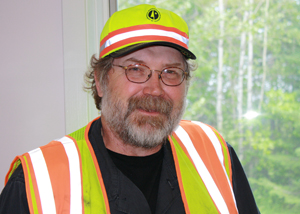
Chris Cheney, District 1 border sub-area supervisor, owned a sheet metal business and worked as a boilermaker/sheet metal worker at Eveleth Taconite Company before coming to MnDOT in 1987. Photo by Justin Capelle |
If you’ve ever worked with Chris Cheney, it’s likely you were close to the Minnesota-Canada border. As the border sub-area supervisor, Cheney keeps busy overseeing the area that includes a big portion of St. Louis, Koochiching and Itasca counties.
Cheney started out as a highway maintenance worker at the Togo truck station in 1987, but has been the border sub-area supervisor for almost three years. He owned a sheet metal business and worked as a boilermaker/sheet metal worker at Eveleth Taconite Company before coming to MnDOT.
The border sub-area includes the International Falls, Little Fork, Deer Lake and Cook truck stations and their surrounding areas. Cheney’s main duties are to get everything to run smoothly and everyone to work together in the border sub-area. He works closely with the transportation generalist seniors in Cook and Little Fork.
What are you working on right now?
This summer we have the opportunity to do wedge paving with the motor grader on Better Patching for Better Roads projects. In June we improved the ride on Hwy 1 and Hwy 65 by blade, laying 1,226 tons of hot mix and an additional 150 tons of wedge paving edge ruts on Hwy 11. Today (July 16) we finished wedging another 150 tons on Hwy 11 and will finish up on Hwy 53 (400 tons) and on Hwy 217 (200 tons) in the next few weeks.
Just like every summer, we are still doing our top cut mowing on all sections, and are busy removing beaver dams. We are also working with excavators and backhoes to finish culvert replacements and major drainage improvement projects. In late summer we will start shoulder repair projects on Hwy 6 and Hwy 65.
What does a typical day look like?
There are no such things as typical days in the summer. We are a reactive workforce, so although we do have a plan, if a tree should fall into the road or if a machine breaks down, we have to respond to the situation. Everyday looks different because of the nature of our work.
The schedule stays pretty consistent on days that we lay pavement mix. My main duty is to coordinate the crews, the pavement plants and the trucks. I wake up at 4 a.m. and call the pavement plant around 5 a.m. to make sure they are making mix and we are on the same page. When we are working in St. Louis or Koochiching counties, most of our pavement mix comes from Gilbert, Minn., which is about 120 miles from Hwy 11. It’s common for our trucks to make one to three rounds a day during pavement days.
What is the busiest time of year?
It is always busy up here because long winters make seasons blend together. Summer is very busy with all of our projects. We work very long days at times when the weather does not cooperate or equipment breaks down. You have to “make hay while the sun shines.”
Winter is busy because we plow snow on all of the highways up here. The routes are very long, so when we have snowstorms the crew may have to work overtime. Autumn and spring are the short seasons up here. Autumn is mainly getting ready for snow and ice, and a bunch of time in the spring is geared towards getting ready for the summer projects.
What makes the border area unique?
It is extremely rural and is very geographically spread out. International Falls is the largest city with 6,000 people, while most of the towns have less than 1,000 people. We have extremely long plow routes up here. In a snowstorm it can take 10 hours just to make one round on our longest route because most of our routes exceed 100 miles round trip.
Up here there is no fast way to get anywhere because it is spread out, and we are isolated from bigger cities. It is a three-hour drive to Duluth. If a crew member from International Falls wants to go to St. Paul for work or leisure it has to be an overnighter because it is a five and a half hour drive one way.
We eat the best food up here. Several members of the crew are avid hunters, fishers and trappers. They bring in their cooked fish, buffalo, deer, moose, beaver, coyote, skunk, etc.
What challenges do you face at your job?
The distance we have to travel for materials is one of our biggest challenges. It takes a long time to get to a mechanic or to get specific parts we need. We usually have to travel more than 100 miles to get the pavement mix we need. If there is a meeting at D1 headquarters in Duluth, it will make for an early start, because from International Falls it is a three-hour drive.
Challenges I face personally are all of the little things that constantly pop up, for example: calls from the State Patrol about trees blocking the roadway from wind storms or beaver; crashes that require traffic control; spills or dead animals and debris on the roadway. I do my best to be ready and available for their calls, day and night throughout the week and on weekends. I like to speak with the public because we are public employees and I am always willing to consider concerns from the folks who use and pay for our roadways.
For the most part my job is easy though because I honestly have an excellent crew. They are all great at what they do and are always helpful.
What is your favorite part of the job?
My favorite part is working with the crew paving the roads, or culvert and drainage work in the summer. Encouraging safe work habits and having the whole crew together and working outdoors is what I like. The ability to see the accomplishments that make our roadways safer for the motoring public in Minnesota occurs in both summer and winter. The social aspect of being around everyone all of the time is different than in the winter, which entails a lot of coordinating on my part and the crews spend a lot of time alone in their plows. |
 |
|

|
|

|
|
| |
|



